How a Robb Report Editor Survived 3 Days Stranded in the Alaskan Wilderness
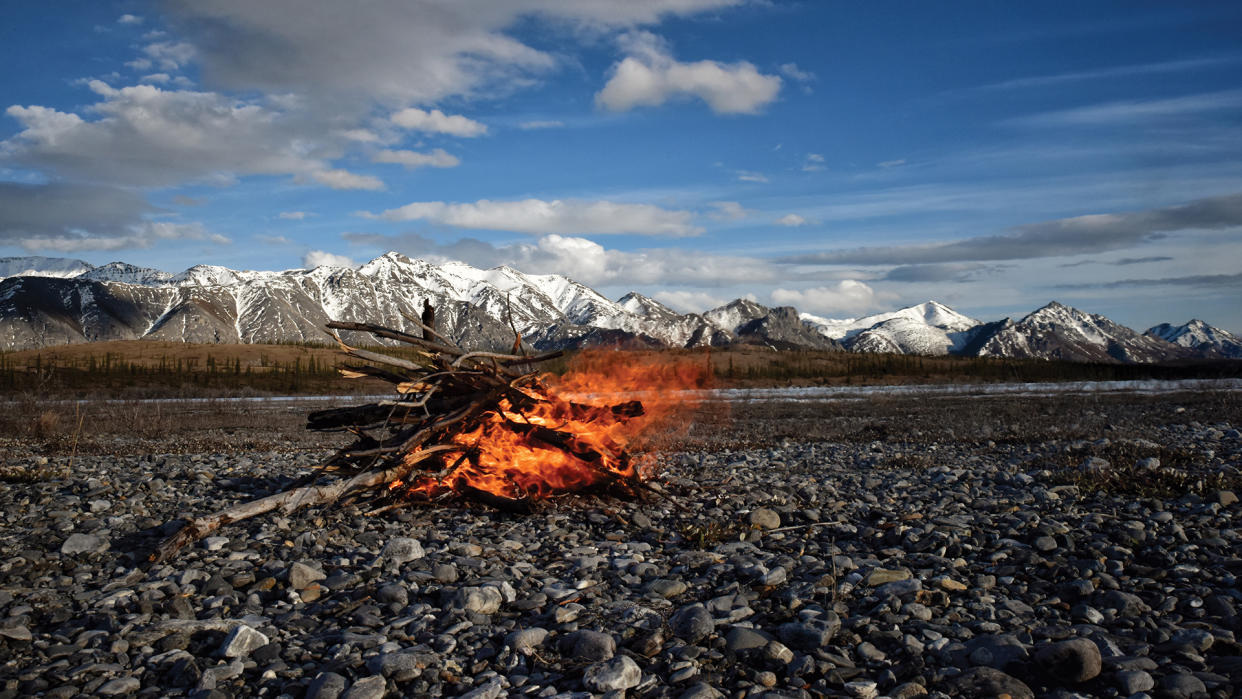
After the earth seems to jump up and bite the right wheel on landing, wrenching the gear leg back on itself like some grotesque football injury, and after the wing slams the ground like a palm hitting a tabletop in anger, when the plane finally finishes its long shuddering slide through the gravel, I sit in the swirling dust and think back to a week before, in a Fairbanks hotel room, as Randy McKinney calmly explained all the ways to die in the Alaskan bush. The list consisted, in part, of freezing, starving, injury, panic, getting lost, general stupidity and bears. Especially bears.
“No one realizes just how dangerous bears are,” said McKinney, my pilot and guide for the next week as I went in search of the Western Arctic herd, the massive caribou migration that takes place across Alaska each spring. “There’s nothing on earth you want less than getting charged by a grizzly.”
More from Robb Report
The Luxury Tourism Market Is Expected to Reach $82 Billion by 2030, a New Reports Says
I Tripped on Mushrooms (Legally) at a Therapy Retreat in Jamaica. It May Have Changed My Life.
These New Yacht Trips Retrace the Steps of Real-Life Pirate Treasure Hunts
By his count he’d been charged 15 times, which explained the guns, a .44 caliber revolver and a pump-action shotgun, sitting on the floral bedspread next to the flight tracker and a pile of assorted camping gear.
McKinney owns Explore Alaska—along with his wife, Lana—which arranges personalized trips to hard-to-reach places throughout the state, to fly-fish or view wildlife. I was there, ostensibly, for the caribou, which McKinney had described as a bona fide natural wonder, and maybe some hiking and a few swims in the type of streams they put on the postcards. But equally I was there because I wanted to understand a frontier, to see the other, outer edge of America. Northern Alaska felt like a cosmic ledger balance against the unrelenting, overcrowded convenience of New York City, where I live, and I thought that if I could somehow glimpse that opposite philosophical and geographic threshold, it would show me… something. I had no idea what. That’s the thing about frontiers: If you know what to expect when you get there, it’s not a frontier.
Aesthetically, McKinney is exactly what you want in an Alaskan bush pilot, a lanky, six-foot two-inch version of Robert Duvall in his 60s with a trim white cowboy mustache and a smooth drawl, who tells stories about characters with names like Stinky Hardy and Two-Jump Joe Tonasket and says folksy things like “tougher than a cast-iron football.” More importantly, he has an array of survival skills learned over an astounding range of jobs; a partial list of his résumé includes cowboy, dog-team driver, insurance-fraud investigator, bear guard, photographer, law-enforcement officer, commercial fisherman and team leader for personal security details. He’s also a doctor of homeopathic medicine and helps counter-poaching efforts in Africa, including by donating all profits from Explore Alaska.
In the Alaskan bush, everything is a matter of life or death. Weather, judgment, gear, information, common sense, patience—the wrong quality or quantity of any one of them can mean oblivion. McKinney ticked through a meticulous audit of the 30-pound survival pack that accompanies him each time he goes airborne: first-aid kit; freeze-dried rations; flares; compass; signaling mirrors; hunting knife; folding handsaw; an anti-dysentery treatment he invented; paracord; tarp; binoculars; several types of fire starter; fishing hooks and line; a water-filtration system. The list went on.
“In Alaska, things can go wrong for any reason,” he said, “or no reason at all.”
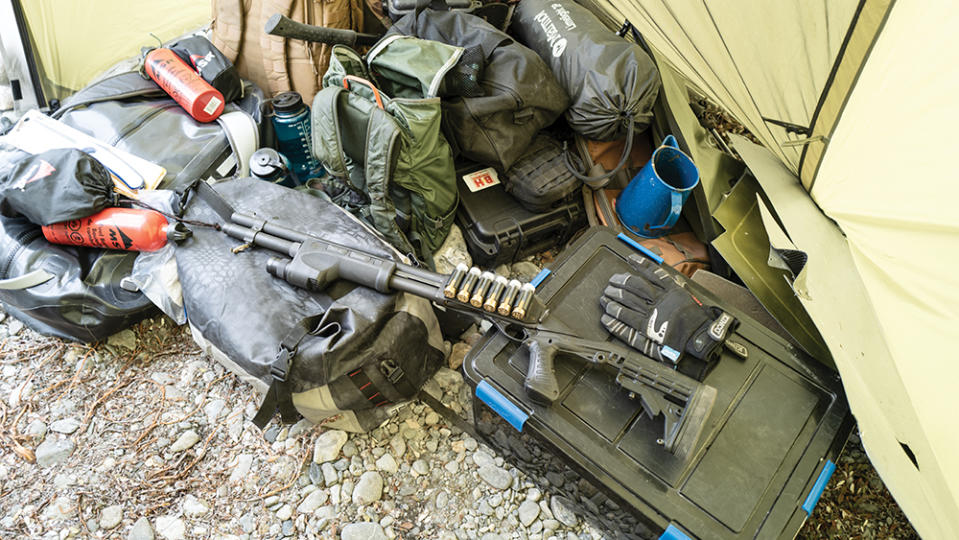
Josh Condon
To drive home the point, he handed me a Bic lighter in a small orange container on a bootlace lanyard, to be worn around my neck every time we flew, one last chance to start a fire should the worst come to pass.
Sitting in a broken plane on a lonely gravel bar hundreds of miles from anywhere, deep in grizzly country above the Arctic Circle, I feel for the lighter beneath my shirt and try to remember everything McKinney told me about staying alive.
Part I: Scud Running The Brooks
It’s not looking too shiny over that way, buddy,” McKinney said over the headset, nodding ahead of us toward a rolling gray wall, dark tendrils of rain snaking down into the mountaintops. Through the clear canopy I glimpsed the plane’s shadow trailing us 800 feet below, a dark smudge blinking in and out of view among thousands of square miles of snow and rock.
Alaska is more than twice the size of Texas but has less than half the population of San Antonio, and few highways. The state is a hotbed for aircraft, particularly bush planes, which in ideal conditions can take off and land within the length of a football field. McKinney’s pristine 2019 Piper Super Cub, heavily modified with lightweight, high-performance carbon-fiber components, can make impromptu airstrips of gravel bars, fields and mountain ridgelines.
But there’s a trade-off: the more stuff you carry, the fewer places you can land. So after flight-planning the route north from Fairbanks to the Arctic Ocean—checking weather cameras and calculating distances, fuel burn, potential wind resistance, cargo weight and gas reserves— McKinney began a ruthless culling from our over-grown pile of gear. First to go was the cooking tent, then a small folding table meant for preparing meals, then the fishing rods, and so on, until he looked up and said, “How do you feel about ditching the chairs?”
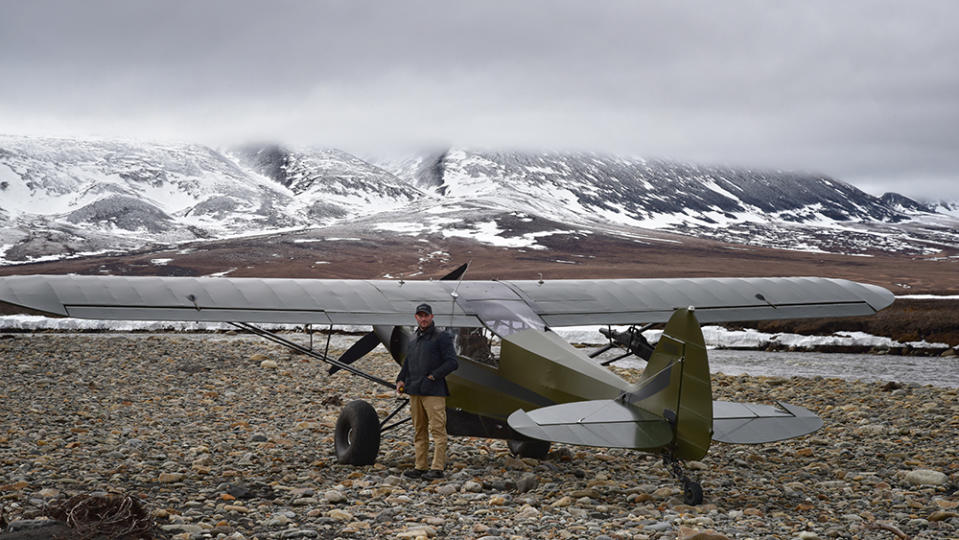
Josh Condon
The reason the Super Cub is the most popular bush plane in the world isn’t horsepower—the Lycoming engine in McKinney’s model produces just 180 hp, about the same as a Mazda Miata—but its light weight, which makes it both agile and fuel- efficient. Super Cubs are an example of what’s known as “fabric-covered aircraft,” which is a disconcertingly literal description: an airframe composed of steel tubes swathed in synthetic cloth. Pilots call them “tube-and-rag planes,” which sounds like a type of toy, and sure enough, rap your fingers along the body and you’ll hear a hollow bong like a child’s drum.
The leading cause of aviation fatalities in small aircraft like these is fuel mismanagement, including improper calculation of range. Given that weight and distance are natural enemies, and considering we had some 400 miles to fly—including the Anaktuvuk Pass, a 160-mile artery through the heart of the Brooks Range, one of the more immense and unexplored mountain systems in the world—the chairs stayed behind. We took off from a grassy airstrip outside Fairbanks, gliding off the ground and skimming over the trees, the cockpit filled with a roar like mating lawnmowers.
As we pushed north, the bright primary colors of Wild Lake and Bettles gave way to muddy browns and blacks, the low scrub that sits atop the base layer of permafrost above the Arctic Circle. The Brooks Range loomed into view, and then we were in it, towering white-capped mountains stretching out in every direction, a sea of gray closing in around us, shouldering through the wind in a plane made of tubes that weighs less than some motorcycles.
We were scud running, chasing breaks in a moving wall of weather, zigzagging back and forth across the plotted course, always traveling downstream, which is to say downhill, the ground falling away in front of the plane acting as a potential escape route, or emergency landing. It’s not a game for amateurs—it’s exacting work, and without patience and a keen sense of the land below it can be deadly, the plane suddenly socked in from all sides, flying blind in thick gray soup, no way to tell whether it’s heading up into a mountain or down toward the ground.
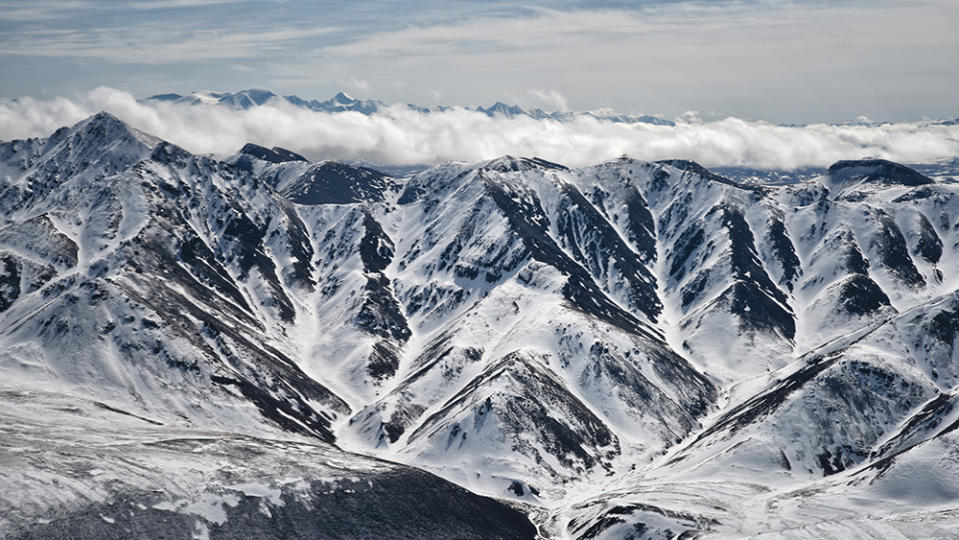
Josh Condon
“If I dropped the whole state of New York down there, you could spend the rest of your life looking for it and not find it,” McKinney said through the headset, nodding out toward the endless mountains. There was no sign of life, the small shadow of the plane the only movement below. We were trying to refuel at Kavik River Camp, on the North Shore just below the Arctic Ocean, before flying to one of the wide, flat ridgelines to the east to set up camp. But the weather was pushing back, jamming us into a headwind, forcing us to take the long way around the weather, burning fuel.
After the better part of an hour dodging clouds, McKinney finally banked west, out of the mountains, toward the Kavik River, announcing our position over the radio and requesting permission to land.
Part II: The Sherp Goes for a Swim
Kavik River Camp has the wholesome, forthright name of some lush getaway with burbling waters and Robert Redford types in waders. In reality it was a cold, flat, muddy expanse of gravel with a mess hall, a pair of outhouses, a cavernous garage and work tent and a series of low, rectangular wooden huts on tall treads called hooches. It was once a logistics base for an oil field; now it hosts hunters and visiting researchers, film crews and scientists. We were weathered in the moment we landed, the sky dropping straight to the ground to deliver a cold, driving rain.
A gargantuan machine rolled up, a red metal box on comically large tires nearly six feet tall. The front windshield folded down and a stout, gray-haired woman started hollering at us for spooking her geese. This was Sue Aikens, who’s lived at Kavik River Camp for the past 23 years and has starred on the BBC reality show Life Below Zero going on 13 of them. McKinney asked permission to set up our tents, but Aikens waved him off and suggested we grab a hooch. There was a fresh grizzly kill less than half a mile from camp, a pregnant caribou strewn about in several pieces, and the bear was in the area, defending his meal. McKinney nodded, at which point I noticed his chest holster and it dawned on me that he had flown the entire route with the .44 strapped across his flight suit. “You have to always fly with a gun,” he replied, “in case the plane goes down and a bear decides to pop up where you land.” The pecking order, though never in doubt, was suddenly tangible: The pilot had a gun; I got a lighter.
The next morning, the wings were dripping in long icicles, visibility limited to a few dozen yards. I loaded up on coffee and spent the morning in the hooch practicing knots McKinney had shown me. Around noon there was a high honking sound, like a bicycle horn. Aikens, in her massive truck, a Ukrainian-made Arctic-exploration vehicle called the Sherp, was offering us a tour.
She talked continuously as we rolled over bushes and chest-high vegetation. Aikens is a preternatural monologist and a poet laureate of freestyle profanity, but her subject matter is always Alaska: bears, the weather, bird hunting, the Kavik River, bear attacks (hers and others), homemade remedies for catastrophic injuries, the ceaseless dark of Arctic winters, her garden, how everyone in the pitiable monolith that is “the lower 48” is living life hopelessly wrong, the wildflowers in bloom (“If you don’t think there’s life up here in the permafrost, you need to get closer to the ground, because you’re only looking for it at human scale and you’re going to miss it”) and bears.
All that was left at the kill site was a shredded half-pelt that was once the mother caribou and a red, knobby shank of the fetus’s spine. Aikens pointed out the grizzly tracks—huge, a catcher’s mitt with claws—and placed a pair of heart-shaped rocks in the aftermath. Then we rolled off in search of the bear.
From the air I had watched how McKinney continuously gleaned information from the earth, reading wind direction in the pattern of ripples across a creek, or following the course of water downstream. From the Sherp, Aikens did something similar but reversed, reading the sky to get a sense of what was happening on the ground—vying flocks of sea birds congregating in the same spot might mean a kill, while agitated ravens could be a passerine bear alarm.
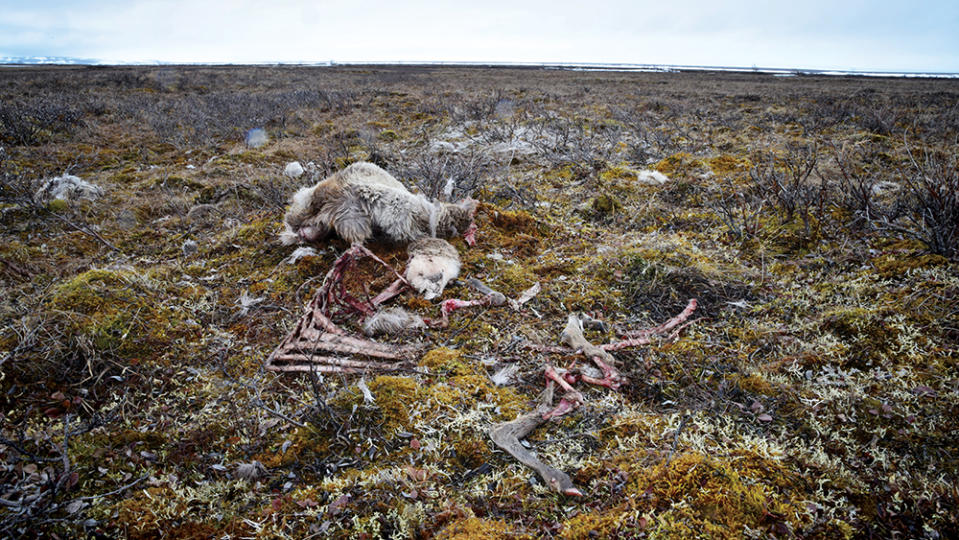
Josh Condon
We picked our way across gravel bars along the Kavik River with no easy place to cross. Aikens flipped a switch, rerouting the exhaust to inflate the gargantuan tires, and the Sherp rolled to the edge of the river. Then a slow, queasy lurch to the driver’s side, one huge tire bobbing, Aikens’s window nearly scraping the gravel as she methodically cursed and worked the controls, briefly pulling us back ashore before pressing forward again, plunging the Sherp into the fast-moving river.
The Sherp, it turned out, couldn’t exactly swim, but it was designed to float. We drifted parallel to the shore for a dozen yards before the rubber found footing on the far bank and Aikens hauled the machine out of the water. We continued on, Aikens stopping her narration only to take a few potshots at a passing flock of geese. Sifting through rocks on the riverbank, she presented me with a gift of fossilized, blue-ribbed colonial coral and showed us stones so suffused with the crude oil that seeps from the ground that they smell like sulfur when scraped: scratch-and-sniff rocks. She expertly mimicked bird calls and projected, for all her boundless energy, the pervasive calm that comes from being intimately connected to the land.
“I’m like the tundra, I just hang around up here,” she said, watching the passing gulls, and I realized that Aikens didn’t mind the adversity or the almost cartoonish dangers: bears, murderous storms, unbroken months of darkness, freezing to death. For her, as for McKinney, and for the aspiring dog musher I met at the gas station at Bettles and for everyone else I had spoken with so far in Alaska, these weren’t challenges in constant need of overcoming. They were part and parcel of one of the last untamed places in America, and everybody I’d met couldn’t conceive of living anywhere else. Sue Aikens, a television star living in a tent at the edge of the Arctic Ocean, her closest neighbor an offshore oil rig, was exactly where she belonged.
McKinney and I spent the next several days at Kavik, the ridgelines to the east too snowbound to land and set up camp. When the weather was clear, we flew along the coast, searching for caribou that refused to materialize except for a few small, scattered groups.
At first it seemed impossible that we could miss half a million large, lumbering animals stretching for miles across flat ground. But the more we flew, the more it came to seem ludicrous that we would ever manage to find something so relatively tiny as the world’s largest overland migration. The few caribou we did see appeared as four or five or seven pin-dot animals trekking across thousands of miles of ice, inconceivably alone.
It was hard to stay mad at the caribou, if only because the terrain was so fascinating. Who knew ice came in so many colors? Rust red, jade, moss, periwinkle, sea glass, lemonade, a tepid brown like weak coffee, the same rich sky blue of a Tiffany’s box. Tantalizingly, the mud and snow were perforated with thousands of tracks, caribou prints in straight, orderly rows and the crisscrossing tracks of the wolf packs hunting them, the awkward pattern of wolverine paws appearing like misplaced quotation marks and, once, as we skimmed 50 feet above the beach, the giant, moccasin-like tracks of a polar bear.
One day we landed on a small, scimitar-shaped sandbar in the Arctic Ocean. The sand was as dark and powdery as espresso grounds, dotted with pale driftwood and gull feathers, and it’s very likely McKinney and I are the only two people to have ever stood on that exact spot on earth. I leaned into the wind and sun and peered out at the vast frozen plain beyond the farthest edge of America.
“Do you hear that?” McKinney asked, and I did. It was the sound of nothing, and it was beautiful.
Part III: Shangri-La on the Hulahula + Socked in Again at Kavik
The days at Kavik ran together, the weather never sitting still, cycling from snow to fog to rain to the midnight sun casting 50-foot shadows across the gravel. The hooch was dark and spartan, but it had a space heater and a reinforced freezer door to keep out snow, and the bears.
McKinney and I made a plan: We’d head out in the morning for one last chance to find the alleged caribou—a visiting ornithologist said he’d heard they were to the east, somewhere along the Hulahula River—then return, pack, refuel and head south, toward sun and warmth and the mineral waters of the Tolovana Hot Springs. It was Tuesday, or I was fairly sure it was.
Setting out for the Hulahula, we found ourselves scud running again, dodging an onslaught of clouds. I asked McKinney to circle back past a particularly menacing mountain for another chance at a photo. On the second pass, framing the peak through the viewfinder, I heard, “What’s that over there?”
We had almost missed it—a clear channel, sunlight in the distance. McKinney made his careful reconnaissance passes, examining the terrain, and the next moment, like The Wizard of Oz blinking into color from black and white, we were soaring through a sunlit valley awash in green—a hidden microclimate, surrounded on all sides by winter, alone in the full bloom of spring. Below, cutting through the plains and carved into the rock along the base of the mountains were the fossilized tracks of millions of hooves, an etched record of caribou migrations going back tens of thousands, hundreds of thousands of years. We cruised the valley for the next 25 minutes, tracing the creeks and the small lakes until the weather turned again and chased us out of the secret paradise, back into the snow and ice.
At Kavik, McKinney veered off his runway approach, thinking he’d spotted a bear. It was the Sherp, bogged in several feet of water covered by an unassuming field of white like snow quicksand. By the time we landed, arranged a rescue team, packed the guns, rode the two miles east, winched the Sherp onto dry land and got back to camp, it was late, and despite the clear skies we gave up the plan to try for the hot springs.
When I awoke at three in the morning, it was snowing again. All at once everything was freezing and exhausting. It seemed I’d never be able to leave the cold muck, and suddenly I felt like demanding that McKinney hotdog us back through the mountains no matter the weather—to carry me away from the cigarette-burned blankets and damp outhouse toilet paper, on the way to grass and trees and warm sun. But I knew he wouldn’t, of course he wouldn’t, and in an instant I was full of rage at the oscillating weather, knowing that all of our plans were at the mercy of something as ephemeral as clouds. The snow, as if in agreement, continued to fall silently around me.
Part IV: Stranded
Sitting in the kneecapped plane, the edges of the propeller torn off, I wiggle and flex every part of myself: It’s all in working order. McKinney, too, is unharmed. We climb out—much more easily now that the plane is sitting on its belly, the starboard wing resting on the ground—and survey the damage: a short stretch of bent airframe, the mangled prop, various patches of shredded rag and the gear leg wrenched 90 degrees in the wrong direction. It’s a series of repairs that will require a hundred smaller bits and pieces, but all of it is either replaceable or fixable.
“Could have been a lot worse,” McKinney says, and there’s no doubt he’s right. At the beginning of our trip, I asked him about crashes: Does anyone get away with being a bush pilot for any length of time without wrecking? He shook his head. “Everybody balls up their plane at one point or another,” he said, and relayed a series of increasingly harrowing tales of other pilots’ bad luck—mechanical failures, boulders hidden in the snow, blitzkrieg weather, being stranded for weeks in a whiteout blizzard, survival hunting, living in a sleeping bag so as not to freeze to death in -70 degrees Fahrenheit. Our situation, by comparison, is idyllic: in a meandering valley in the shadow of unnamed mountains, the East Fork of the Chandalar River rushing past to the east. The reason we were landing was to determine whether we wanted to camp there for the night, until the right wheel hit a hole, at which point the decision was made for us.
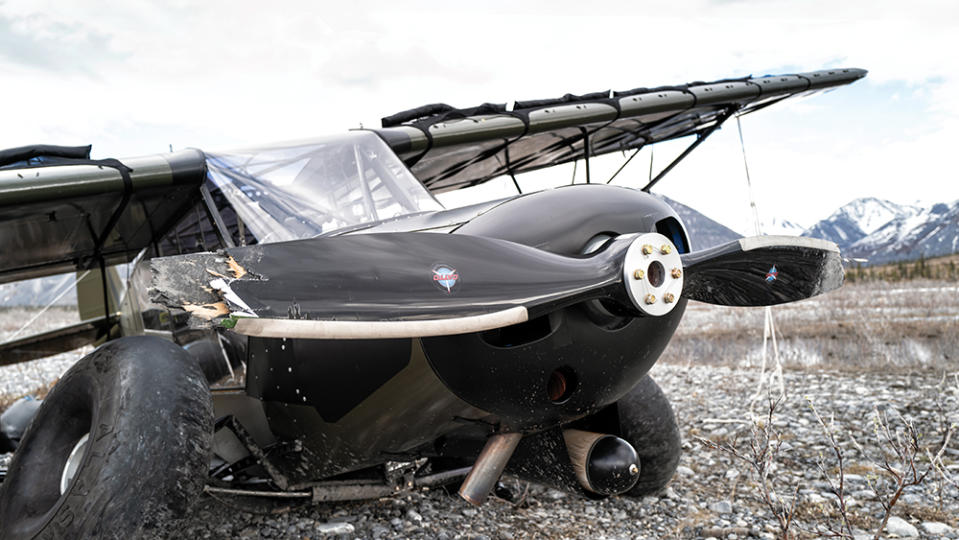
Josh Condon
We unload what we can from the plane, the front of the belly pod crushed under the weight of the cockpit; the camp stove, survival pack and fuel bags are all jammed together up front, unreachable from the rear loading door. McKinney unstraps the axe and starts chopping, cutting a long, jagged hole in the container’s side. With some wiggling and heaving, we pull out the remaining gear and begin to set up camp.
Even just over 130 miles south of Kavik, the weather is more in tune with spring—which is to say it’s not snowing—but we’re still above the Arctic Circle. We manage to set up the two-person tent next to a small creek moments before the sun disappears and a brutal wind whips in from the east, tearing out several guylines and bending a handful of titanium stakes; I catch the tent accidentally, standing downwind when the gust slaps the fabric into my chest on its way to blowing into the water. We run out more guylines, re-drive the stakes and pile a barbell’s worth of large rocks on top of each.
McKinney calls Lana on the satellite phone to update her on the situation and confirm our coordinates—she’s been continually monitoring our whereabouts on the flight tracker—and together they start devising a plan: components, materials and tools needed to fix the plane; stores that sell each; a list of people to call, to see who can come to the rescue or lend parts; our food situation (light; we left the majority of our provisions behind in Kavik, to save weight, though we still have some eggs and meat and several days’ worth of freeze-dried survival rations); and a realistic timeline for getting everything procured, packed, flown in, fixed and flyable. A couple of days at best, more likely several.
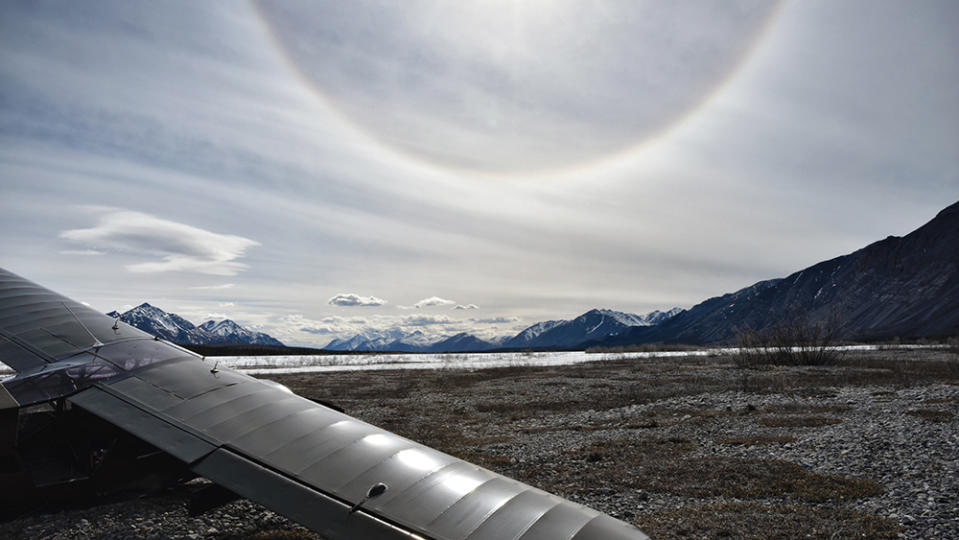
Josh Condon
The next morning I wake around six and head down to the creek with the portable filtration system from the survival pack. The water is several inches deep and cold enough that shards of ice drift across the surface like in a well-shaken martini. I pump and listen to the flowing creek and watch the clouds settle over the nearest ridgeline and realize that, despite having spent the night before in a two-person tent, in a battering wind, within arm’s reach of a large handgun, I slept very well and I feel oddly refreshed.
As I walk back to the tent, McKinney puts a finger to his lips and points behind me. A herd of caribou stares at us from the brush, a stone’s throw away. A large bull, 400 pounds with towering black velvet antlers, locks eyes with me for a long moment, then snorts and turns, the rest of the herd following. Within moments they casually exit the bush, wade the creek and the river and disappear into the far timber. Six days unsuccessfully chasing caribou, with every man-made advantage of speed and vision and range, and the cud-chewing bastards got the drop on me.
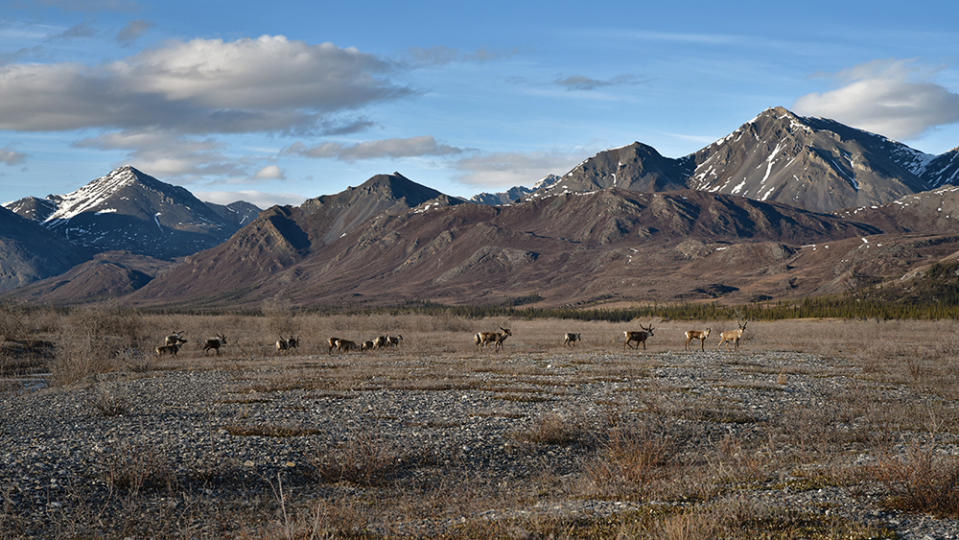
Josh Condon
McKinney tells me to wear the .44 at all times—cooking, writing, doing dishes, ducking behind the large thatch of bushes across the creek we’ve designated as the bathroom. “Grizzlies hunt the caribou,” he reminds me.
I fry slices of bread for breakfast alongside a half dozen scrambled eggs with cubes of buffalo sausage. Over the satellite phone, Lana relays that none of McKinney’s plane-owning friends are available to deliver parts: Two have engines undergoing maintenance, one is guiding a hunt and the other is heading to Michigan for a family reunion. “Well, we’ll need an airstrip at some point,” McKinney says to me, taking the shotgun and handing me the pistol, and we walk off in search of a runway.
An hour later we find a workable patch some 200 yards from the camp, mostly flat for several hundred feet and running parallel to a small creek. The only issue is the vegetation: chest-high clusters of birch saplings and small, gnarly bushes with tough roots twisted through the rocky soil, a thousand sharp awkward plants that all need to be cleared from the airstrip, the taller branches at the edges of the runway cut down to waist height to avoid snagging a wingtip.
The bushes are too small and the saplings too pliable for the axe, so we get to work with a serrated pocketknife and the folding handsaw from the survival pack, hot hours of kneeling in gravel and hardpack, yanking at roots and trying not to drive the saw into the sand as the gun holster bounces against my chest.
Several hours later, during a hasty lunch of protein bars, there’s good news. Geordy Pine, a 21-year-old hunting guide and part-time pilot for Explore Alaska, is skipping his family reunion to come help. First, however, he has to secure every item on the long list, which means raiding his own garage, then McKinney’s garage, then the garages of friends and neighbors, then flying four hours from Tok to Fairbanks, where Lana is making the rounds of aviation-supply stores. Then he needs to pack all the gear into his Super Cub, then fly another five hours to our location. The trip will require refueling several times, and the schedule for all of this, of course, depends on what the weather decides to do, which means the only sure thing is that he won’t arrive until later in the week.
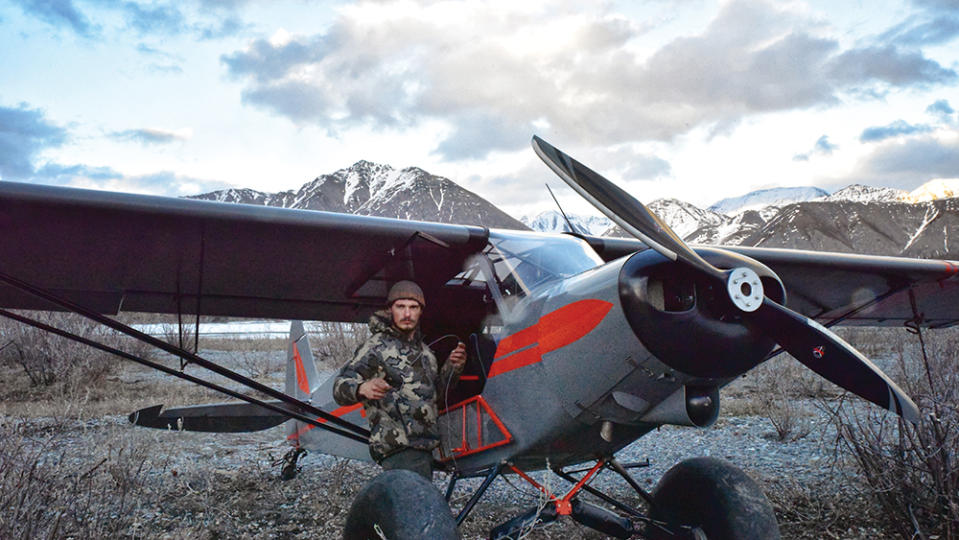
Josh Condon
We head back to the airstrip, spotting a foot-high mound of scat and a grizzly print in the mud, six inches wide and eleven inches long, not including the claws, though neither is fresh. We spend another four hours clearing brush, the work punctuated by the distant, echoing booms of ice shelves cleaving off into the river below. We finish work around eight and eat dinner squatting by the tent, watching a new herd of caribou laze in the rock field. Before bed, we fill the coffee mugs with silverware and stack them on the lid of the food bin as a bear alarm.
The next morning, Thursday. McKinney has been up for an hour working on the plane when I stumble out of the tent just past six. More good news from Lana: If the weather cooperates, Pine will arrive at Fairbanks that afternoon and expects to reach us at some point this evening. We squat in the tent, waiting out a torrential rain and scarfing a few protein bars, then grab the guns and head back to the airstrip.
After lunch—the last of the eggs—something interesting happens. I’m waiting for the water to boil for the washing up when I find a bottle of honey in the food bin, so I squeeze a glob onto a spoon. As I sit on my duffel bag, gazing out the tent door at the mountains, the honey hits some mainline pleasure artery and my neuroreceptors light up like a jackpot slot machine. In the moment, there’s nothing but the comfort of sitting after hard labor, the honey’s rich sweetness, the warmth of the sun as it breaks through the clouds to spotlight a distant peak. There are no distractions—my phone and computer are useless bricks in the bottom of my pack; I haven’t seen an email, a news story, Instagram or even a reflection of my own face for over a week—and I realize that, even though I’ve been lucky enough to have eaten in some of the best restaurants in the world, this simple tablespoon of honey is the greatest dessert I’ve ever tasted.
We finish clearing the airstrip around five, then pile mounds of brush into nearby ditches to mark them as no-go zones. McKinney paces off the airstrip as I stand bear guard with the shotgun: After 15 hours over two days, we’ve carved 760 feet of airstrip out of inhospitable earth using nothing but a folding saw and a pocketknife. Back at camp, we sit and listen for the sound of an approaching plane and watch a far-off herd of caribou gallop silently across the ice.
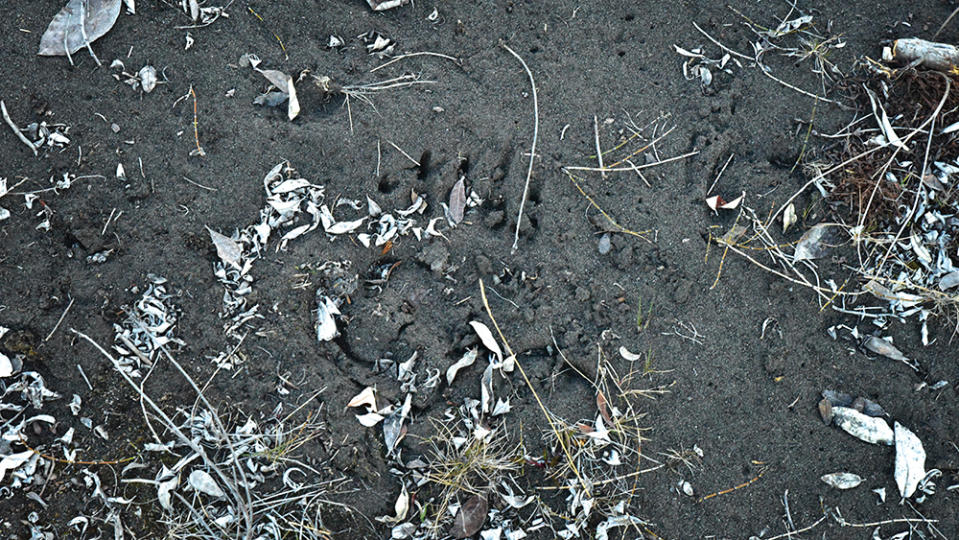
Josh Condon
Three hours later, 8 pm exactly, the unmistakable low whine of a Super Cub in the distance. We hustle over to the airstrip as the gray and orange plane appears, a dot over the mountains, getting bigger, lower, swooping down to make a pass, then another, touching the tires to the ground before rising again into the air, banking, banking again and coming in for a landing. McKinney pops a flare so Pine can read the wind direction, the yellow smoke blowing west to east. Pine’s plane, loaded with gear, uses most of the runway to come to a stop; McKinney and I whoop and high-five when he finally kills the engine. Pine climbs out of the plane. He has green eyes in a tan face, curly brown hair, a hunter’s unkempt beard. He takes a look around and says, “Wow, you guys are way out here.”
The work resumes immediately: unloading the plane and hauling the gear to camp, getting a six-foot-tall jack under the downed wing, McKinney and Pine starting repairs. By the time we crawl into our tents, it’s well past one in the morning.
Friday. McKinney and Pine are at work as I cook breakfast, fried discs of buffalo sausage, the last of the real food as there was no room for extra provisions in Pine’s plane. I notice the two of them huddling. McKinney walks over to me. They’ve discovered some part or other that needs to be replaced, something he couldn’t see until the wing was in the air. It wasn’t on the list.
“Geordy’s flying back to Fairbanks today,” he says, “and you’re going with him.”
It seems wrong, escaping before the job is done. More than that, I suddenly realize, I don’t want to go. The minor anxieties of modern life, asleep for the past 10 days, jump awake and start yowling for attention, demanding to be fed.
In the bush, there are no email backlogs, no train delays or parking tickets or smog warnings. There’s time, especially under a midnight sun, but very little of it to waste. Life is reduced to providing yourself with what few comforts you can—a warm breakfast, a spoonful of honey—after you’ve finished all the work necessary for staying alive. After time these comforts take on outsize meaning, blooming, transforming into moments of profound joy: icy creek water when you’re thirsty; warmth, after being cold for a week straight. I consider protesting my exit, but I know it wouldn’t do any good.
As Pine goes through his preflight inspection, McKinney and I regard each other for a moment. For 10 days we haven’t been more than a hundred yards apart, and now I’m going home and he isn’t. McKinney leans over and wraps me in an unexpected hug. I thank him for keeping me safe, for orchestrating an extraction and especially for never taking any unnecessary risk, beyond the obvious one that is flying a small plane over dangerous country. If it weren’t for his expertise, his ability to improvise, adapt and overcome, things could have been much worse. I’m grateful to realize I’ve spent the past 10 days learning from a consummate Alaskan.
Pine’s plane bounces over the rocks, picking up speed, and then the wheels are off the ground and we’re airborne, the earth dropping away, McKinney getting smaller. Suddenly I can make it out from the air, the long runway that wasn’t there three days ago—my infinitesimal mark on the remote wilderness of the Alaskan bush, a last outpost of America where few have ever been. And for the first time I feel it, and I’ve felt it every day since, the mark the bush made on me: a deep and unshakable stillness. The sound of nothing at the edge of the world.
Best of Robb Report
The Ultimate Miami Spa Guide: 15 Luxurious Places to Treat Yourself
The 7 Most Insanely Luxurious Spas in the World, From Tokyo to Iceland
17 Reasons the Caribbean Should Be at the Top of Your Travel Itinerary
Sign up for Robb Report's Newsletter. For the latest news, follow us on Facebook, Twitter, and Instagram.

